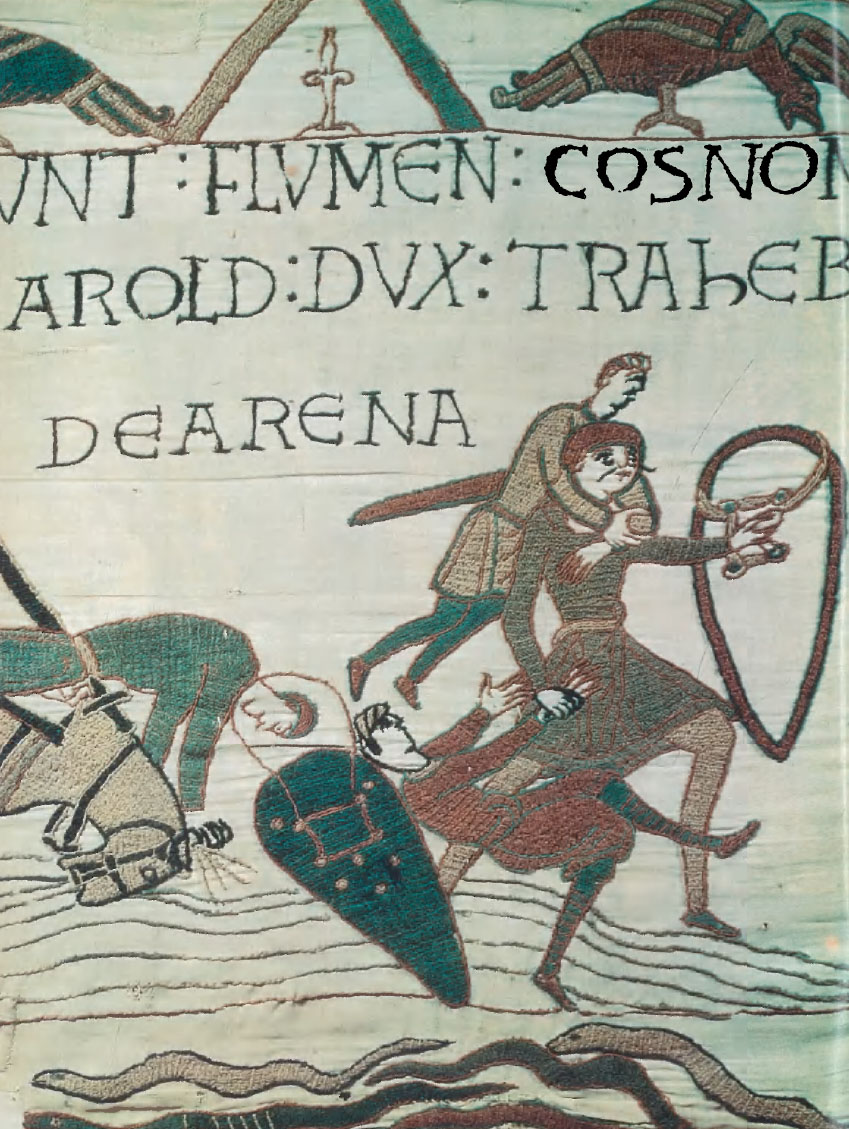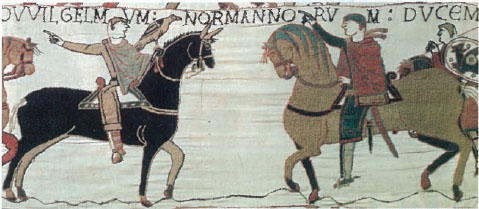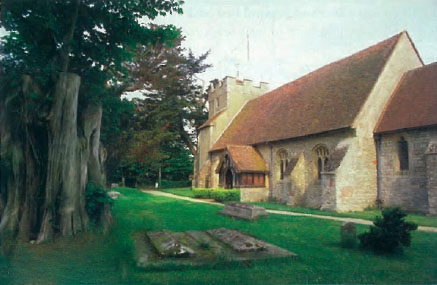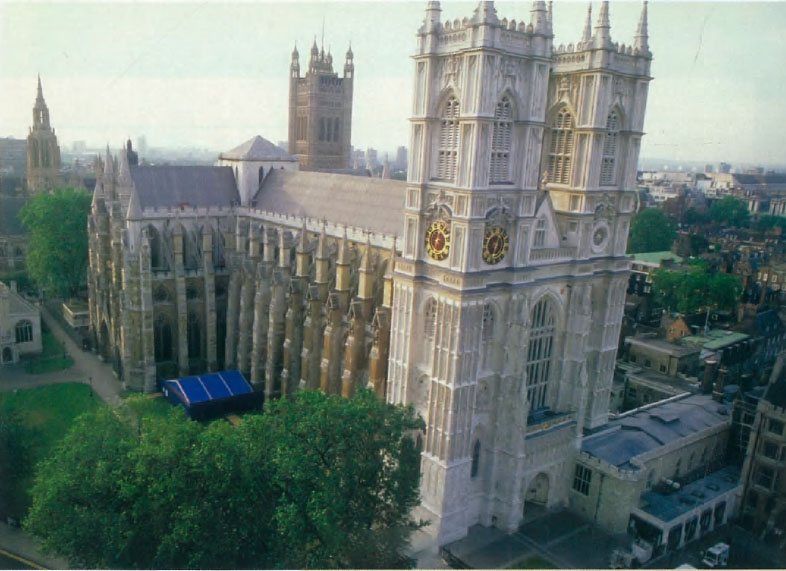
HAROLD AND WILLIAM EACH THOUGHT HIS OWN CLAIM TO ENGLAND’S THRONE WAS LEGITIMATE, BUT IN THE END, MIGHT WOULD DETERMINE RIGHT.
[caption id="TheEarlandtheDuke_Feature" align="aligncenter" width="1024"]

[caption id="TheEarlandtheDuke_img1" align="alignright" width="849"]

IN ONE SENSE, it was all Edward the Confessor’s fault. The King of Anglo-Saxon England had ruled for 24 years, and yet he failed to make it absolutely clear who should
ascend to the throne upon his death. What’s more, the question would never have arisen had Edward discharged a king’s most fundamental responsibility to his subjects and sired an heir. Still, when it came right down to it, the final decision was not Edward’s. The Witan, the national ruling council, had the sole right to appoint a successor.
Of course, the King’s own wishes would carry a great deal of weight with the Witan—most likely decisive weight. But Edward apparently couldn’t make a decision that he could stick with. According to William, the Duke of Normandy, Edward had promised the throne to him in about 1051. And in 1064, when Edward had sent Harold Godwinson, his brother-in-law and Earl of Wessex, to Normandy to inquire as to whether William still desired to sit on the throne of England, the answer had been unequivocally affirmative.
But on 28th December 1065, as Edward lay on his deathbed, slipping in and out of consciousness, he pronounced Harold himself as his heir in the presence of many witnesses. When the Witan met the next day, they affirmed Harold as England’s next King. Whether Edward’s mind had changed under the influence of cool reason or hot delirium, the effect was identical. William’s expectations, if not his ambition, had been unexpectedly thwarted.
THE BACKGROUNDS OF THE EARL OF WESSEX and the Duke of Normandy embodied the ethnic tensions that dominated English politics toward the end of the first millennium. In the middle of the 9th century, the Norsemen who had raided the English coasts for generations began to establish permanent settlements in Britain. During the rule of the Saxon King, Ethelred the Unready, the Danish invasions intensified, were repelled, and returned with a vengeance, leading ultimately to the Saxons’ submission to Danish rule. Ethelred fled to Normandy, setting a precedent that soon became a familiar custom.
In 1017 the Danish King Canute married the widow of King Ethelred in an effort to unite the two rival factions, but loyalties were still sharply divided. Ethelred’s sons, Alfred and Edward, remained in exile in Normandy until Harold I, son of Canute, succeeded his father. Even then, the brothers’return proved premature. Alfred was killed and Edward fled back to Normandy. He would have to wait seven more years, through the reigns of the Danish Kings Harold and Hardicanute, before being named King of the English people.
[caption id="TheEarlandtheDuke_img2" align="alignright" width="479"]

Edward’s years in Normandy had a lasting effect on his choice of counsellors. Having spent much of his life among the Normans, who were themselves transplanted Danes, Edward felt more comfortable among them than among the English, and he surrounded himself with Norman priests and courtiers, to the dissatisfaction of the English nobles.
Perhaps at the last, King Edward feared that offering the throne to a Norman Duke would not sit well with many of his subjects and could ultimately lead to an uprising. If so, his last-minute decision to name Harold in his stead proved to be an ineffective remedy, even though Harold was, arguably at least, the more qualified candidate.
[caption id="TheEarlandtheDuke_img3" align="alignleft" width="138"]

WITH SPECIAL AUTHORIZATION OF THE CITY OF BAYEUX
Harold had been Edward’s right-hand man and an able negotiator and ambassador. To Harold’s credit, he seems to have had a strong sense of honour and justice, which compelled him to side even against his own heavy-handed brother—Tostig, the Earl of Northumbria—when the Northumbrians had rebelled against Tostig’s tyrannical rule.
BEFORE HAROLD MET WILLIAM on the field of battle at Hastings, each had ample opportunity to assess the other’s character during Harold’s diplomatic mission on behalf of King Edward in 1064. The mission got off to an embarrassing start for Harold when a storm drove his ship off course while he was crossing the English Channel, and he was forced ashore on the lands of Count Guy of Ponthieu, an enemy of Duke William.
[caption id="TheEarlandtheDuke_img4" align="alignright" width="437"]

WWW.BRITAINONVIEW.COM
1066:
HOLY TRINITY CHURCH, BOSHAM
tHIS SAXON CHURCH has the unique distinction of being pictured on the Bayeux Tapestry. The church and manor of Bosham belonged to Godwin, Harold’s father, and Harold inherited them upon Godwin’s death. Harold stopped at the church to pray before his voyage to Normandy in 1064.
Two Saxon coffins discovered beneath the floor in 1875 were believed to contain the remains of Godwin and a daughter of the Danish King, Canute, who drowned nearby. The identification of the bones has since been hotly debated.
Those who wish to emulate Harold can attend services on Sun at 8, 9.30, or 11 am; Mon, 8 am; Tue, 11 am; Thurs 6.30 pm; or Sat 8.30 am. Tel: 01243 573228.
Guy detained Harold and his escort, but word reached Duke William, who indignantly demanded Harold’s release. As the Duke was not a man above resorting to overwhelming military force, Count Guy complied. Harold was thus freed, but indebted to William—a situation which must have made him uneasy. Harold’s sense of honour would have compelled him to acknowledge this debt to his benefactor, but he clearly believed himself to have the better claim to England’s throne. William, on the other hand, seems to have seen an opportunity to turn the unexpected incident to his advantage.
Two episodes during Harold’s stay in Normandy lend insight into the character of each man. When word came to William that the Count of Brittany had besieged the town of Dol, William marched to its rescue, and invited Harold to accompany him. The path of William’s march took his troops past Mont Saint Michel and the mouth of the River Couesnon. Crossing the river posed a hazard, as quicksand awaited anyone who veered off the narrow safe route across the shoals.
Sure enough, one of William’s men fell off his horse and into the quicksand. Details of what happened next are sketchy, but it would seem as though William, perhaps considering the sad situation of no consequence to the outcome of the campaign, simply left the unlucky soldier to his fate. Harold, however, rode to the struggling man and, at great personal risk, pulled him out of the mire.
In contrast to this selfless and spontaneous act, William’s actions during Harold’s stay seemed calculated to back Harold into a disadvantageous political corner and to use Harold’s own sense of honour against him. At a banquet held following the successful completion of William’s campaign against the Count of Brittany, William unexpectedly called Harold before the assembled guests, asked him to lay his hands on the sacred relics of St. Rasyphus and St. Ravennus, and then to swear loyalty to Duke William. Harold was faced with two options: either refuse the "honour" and thus insult his host in the presence of his court, or become William’s vassal, beholden to his commands. As the representative of the King of England, he found neither option acceptable.
We can only wonder what went through Harold’s mind in the few seconds that must have passed before a reply became necessary. In the end, his answer was the more expedient one. He pledged his loyalty to William, then rushed back to England.
FOR WILLIAM, the pledge he had exacted from Harold provided ample justification for declaring himself to be the injured party when Harold accepted the Kingship of England. And by branding Harold as an oath-breaker, William also won the support of the Pope. For Harold and his English supporters, an oath given under duress was not binding and simply revealed William as a schemer who did not deserve the right to govern England.
Historians ever since have debated who had the more valid claim. The most telling verdict, though, was surely made by that anonymous political theorist who observed that "might makes right." And as the year 1066 rolled around, it became clear that the matter would be resolved militarily.
[caption id="TheEarlandtheDuke_img5" align="aligncenter" width="786"]

WWW.BRITAINONVIEW.COM
1066: EDWARD THE CONFESSOR’S CHAPEL, WESTMINSTER ABBEY, LONDON
eDWARD THE CONFESSOR had a great sense of timing. The new abbey he had commissioned to supersede the Benedictine monastery that stood near his Palace of Westminster was finished on 28th December 1065. Edward died a few days later, just in time to be buried in a place of honour behind the newly consecrated altar. His elevation to sainthood in 1161 made his shrine a destination of pilgrims during the Middle Ages.
As abbeys go, Edward’s did not long outlast him. By the middle of the 13th century, Henry III pulled it down to make way for an even grander building. At the same time, Henry gave the Confessor’s tomb a facelift. The new shrine has survived to the present day, although in a somewhat reduced condition.
The elaborate gold and bejewelled shrine attracted many infirm Christians, who slept next to the dead saint in the hope of being cured. After the Reformation, the monks dismantled the shrine and reburied Edward elsewhere to put a stop to such excesses. During the reign of Bloody Mary the tomb was partially but inaccurately restored. Nevertheless, it remains an impressive monument to the man who passed his crown to Harold.
The floor of the Confessor’s Chapel is currently undergoing a restoration of its own and access is restricted.
Westminster Abbey is open for visitors: Mon-Fri 9.30 am-3.45 pm (Wed 9.30 am-7 pm), and Sat 9.30 am-1.45 pm. The Abbey Museum opens daily 10.30 am-4 pm. Verger-led tours cost £4 per person. Tel: 020 7654 4900.





Comments